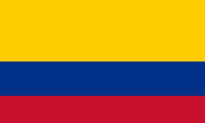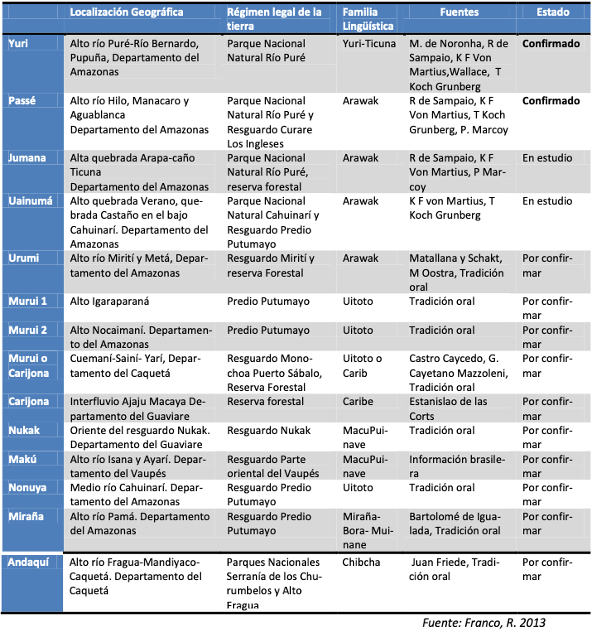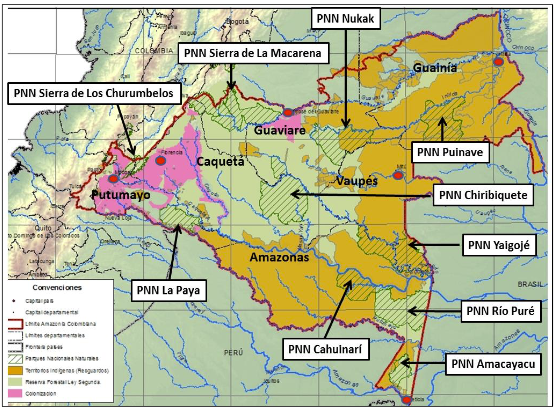
PIACI Diagnosis - Colombia
Preparation of original documents:
DANIEL ARISTIZÁBAL CORREDOR 2013 – HUGO A. ZAPATA A. 2014
National Facilitators – Colombia – ACTO/IDB Program
2013 – 2014
INDIGENOUS PEOPLES IN ISOLATION OR INITIAL CONTACT IN COLOMBIA
In Colombia, according to the Committee for the Protection of Peoples in Isolation, “initial contact is considered to be an indigenous people or segment of people whose cultural, political, social, economic and reproductive difference in relation to the regional society of their environment is transformed in social marginalization, economic inequality, social exclusion and high immunological, demographic, political and territorial vulnerability. This situation of inequality does not allow them to exercise their self-determination to opt for integration into the dominant society or for isolation”.

MAPA INTERATIVO
Observe no mapa interativo do Módulo Povos Indígenas, onde se localizam os territórios indígenas na região amazônica e observe as regiões fronteiriças estudadas pelos consultores da OTCA:
VULNERABILITIES AND THREATS
In 2005, according to official data, the Colombian Amazon had a population of 960,230 inhabitants, equivalent to 2.3% of the Colombian population, of which 86,417 are indigenous. Most of the inhabitants of the Amazon, according to the same survey, are concentrated in the departments of Caquetá and Putumayo (31% of the region’s population and almost half of the population lives in the departmental and municipal capitals, with the majority being Florencia (Caquetá), then with 130,000 inhabitants, San José del Guaviare and Mocoa with about 35,000 inhabitants, and Leticia (Amazonas) with approximately 25,000 inhabitants.The indigenous peoples are distributed throughout the region, some in the vicinity of the urban centers, but mainly in rural communities and reserves, which in many cases include territories that overlap with National Natural Parks.
The Map shows the approximate location of indigenous peoples, reserves, natural parks, colonization zones and forest reserves in Colombia.

On indigenous reservations, colonization projects and extractive activities of all kinds are legally prohibited; however, many of these territories were invaded by settlers, illegal mining, drug trafficking, illicit crops, and also by armed groups such as the guerrilla, paramilitaries, and the state public force itself. In forest reserve areas, on the other hand, there may be extractive activity of natural resources through licenses or permits issued by the state, and these are territories subject to colonization by subtracting territory from the reserve that is later titled to peasants.
Many indigenous peoples live in isolation in the Amazon region by choice and also to avoid various situations of violence and experiences or disease epidemics that have occurred in the last five centuries. Isolation is basically a survival strategy and in most cases it has been effective.
Currently in Colombia the importance and discussion of the issue of the protection that the State must guarantee to the PIACI is growing. A series of situations threaten and endanger these populations and were classified as significant risks:
- The advance of the agricultural frontier and colonization
- Oil exploration, closer and closer and with growing interest in their lands.
- Gold extraction in areas close to communities
- Guerrillas and paramilitaries that are in PIACI territory, confront each other or the National Army
- Coca crops and drug trafficking, fumigation of these crops with deterioration of the environment and affecting food availability, food security and contamination of water sources
- Infectious diseases such as ARI and EDA, which remain the leading cause of illness and death in all indigenous populations.
- Loss of traditional medicine, self-care practices, and disease prevention.
- Cultural colonization in health, education, religion, food, market economy
- Sexual violence and miscegenation
- The sedentarization and use of indigenous people as labor
- Corruption and administrative and political instability that impede the development and continuity of health programs
- The institutional model of health that continues to be very conventional, undifferentiated and not suitable for indigenous cultures.
- Food insecurity generated by the loss of territories and competition for resources with settlers and other actors with economic interests
- The dismantling of institutional and state actions in the different care plans and programs for indigenous populations.
HEALTH SYSTEMS
The government areas responsible for Health and Social Protection recognize the importance of defining specific health actions for peoples in isolation.
According to representatives of the Ministry, there are advances in protocols or health policies for the AIPs, but specialized action on indigenous issues and resources within the ministries is still incipient. The Indigenous and Intercultural Health System (SISPI) is in the process of being implemented within the scope of the indigenous health subcommission, made up of indigenous representatives and members of the government.
